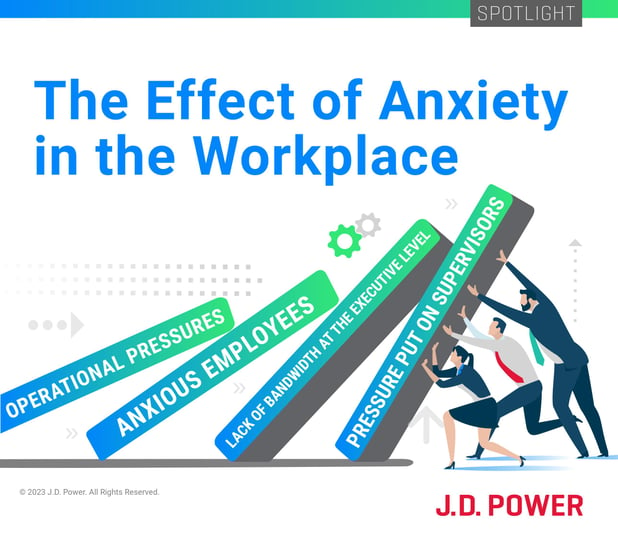Why the Band-Aid Approach Won’t Solve Workplace Anxiety
It is no secret that anxiety has become a prevalent issue for many Americans, but how concerned should corporations be about stress in the workplace? According to Gallup’s most recent State of the Global Workplace Report, employee stress is at an all-time high, with U.S. workers being some of the most stressed employees in the world. Some other concerning statistics from The American Institute of Stress reveal:
- 83% of U.S. workers suffer from work-related stress, with 25% saying their job is the number one stressor in their lives.
- Every day, about one million Americans miss work due to stress.
For many, the pandemic was the catalyst for their stress. Emerging economic and societal concerns are exacerbating anxiety, and these feelings are noticeably creeping into the workplace. Millennials and Gen Z are suffering from mental health concerns at an unprecedented rate. We saw record numbers of younger employees leaving their jobs last year, citing mental health concerns as the reason.
How is anxiety impacting the customer experience?
Years of studies have revealed a strong correlation between the employee experience and the customer experience. When anxiety takes hold at every organizational level, performance becomes impacted. Mark Miller, Customer Service Advisory Practice Leader at J.D. Power, points out that workplace stress can be caused by a variety of factors that originate from a central root cause.
“There has been this radical shift of pressure and responsibility to the frontline supervisors. Leaders across industries have not been as good as we could be around recognizing that massive shift in responsibility. "
“If you take a contact center as an example, you're used to a whole wide array of support mechanisms in place and available for employees that now, from a practical standpoint, really aren't there anymore. That puts enormous pressure on the frontline supervisors who are now wearing all these different hats. And of course, the number one reason for attrition inside contact centers is not pay, it’s their supervisors,” Miller said.

Stress is contagious, and when not dealt with properly, can have a domino effect throughout your organization. Executives pass on stress to supervisors lacking support, which in turn causes anxiety to trickle down among the teams they manage. This flow of anxiety throughout a corporation impacts the customer experience.
An overworked and stressed-out team does not have the time to prioritize customer needs when they are struggling to make it through their workday. Customers are served and provided with better experiences by happy employees.
How can we measure anxiety levels within the workforce?
With the rising cost of finding, recruiting, and training new talent, organizations are more motivated than ever to retain employees and understand their motivations. What can you do to gauge how your employees are feeling about their workplace experience?
- Questionnaires and performance reviews are a great starting point.
- Use clinician-backed tests like GAD-7 and HAM-A to assess the intensity level of stress and burnout from your team.
- Have regular check-ins with team members on a quarterly or even monthly basis.
Once you have a grasp on the anxiety levels across the workplace, you can start taking action to address burnout rates.
How can you reduce stress?
One of the most significant changes an organization can make to help their employees deal with stress is to create real meaning and purpose in the workplace.
To make long-lasting structural changes, ensure there is a focus on the long-term employee experience. Giving out company discounts or offering group meditation classes are band-aid approaches to dealing with this problem. These slight changes are not moving the needle in terms of creating a place where employees find meaning in what they do.
Instead, the answer is investing in solutions that provide support such as offering mental health services. Illustrating to your team that you are invested in their wellbeing will help them feel supported.
The process of creating a meaningful environment needs to include a proactive strategy at every stage of the employee lifecycle. For example, communicate to your new team members that they are working with a supportive organization even before day one.
How can you get started?
Without intentional action, stress isn’t going away and will only continue to permeate and cause more damage to your organization and your bottom line.
The first step to making real, long-lasting change is looking internally and asking yourself: Are we creating safe places and encouraging our leaders to engage our employees, and do we have a mechanism to measure this?” If the answer to either question is no, then take these steps:
- Ask the leaders within your organization to do a reflective self-assessment by asking themselves: “Am I, as a leader, creating an environment for my team members where openness and acknowledgement is acceptable?”
- Measure and assess the current baseline among your team. Are they looking to quit? Are they motivated to stay and grow? Don’t wait a year to get this baseline. Start measuring employee sentiment now.
- Create a cadence of regular dialogue between employees and leaders and encourage employees to speak out.
Intentional changes can have a significant impact on attrition and help you to retain your top talent. Trained and experienced employees are the heart of your organization, providing incredible experiences for your customers. Customer satisfaction depends on these top-performing employees, and reducing stress is crucial to keeping (and developing) extraordinary talent on your team.
To learn more, listen in to this episode of our Winning the Battle for Talent podcast where our experts further explore anxiety in the workplace.
Share this
You May Also Like
These Related Stories

How to Solve the “Ghosting” Issue in the Workplace

Why Chat is an Important Part of Your CX Strategy


No Comments Yet
Let us know what you think